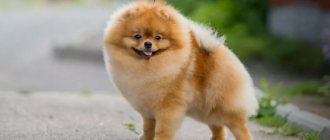Poodles are one of the most popular dog breeds in the world, known since ancient times.
These are friendly, affectionate and playful animals that make wonderful pets, and only a few other breeds can compare with them in intelligence and intelligence.
It is not surprising that poodle owners adore their pets and want them to delight them with their presence for as long as possible.
How long can poodles live at home and how much does their life expectancy differ depending on what size variety they belong to?
Lifespan of the standard variety
Many Royal Poodle owners believe that their pet's lifespan depends on gender. Some poodle owners believe that boys can live longer than girls, while others think that females live longer than males.
In fact, how long a poodle will live depends not so much on the gender of the dog, but on its heredity, living conditions, nutrition, and also on its state of health.
If a poodle grew up healthy from puppyhood and remained active and energetic until old age, then it has a chance of becoming a long-liver. A dog that is sick from an early age is unlikely to live long.
If we talk about diseases associated with the genitourinary system and shortening the life expectancy of royal poodles, it should be noted that they can develop in both males and females.
If the owner is afraid that the dog may live less due to the possible occurrence of fatal diseases of the reproductive system, he can spay or neuter his pet.
The minimum lifespan of royal poodles is 8-10 years: this is how long dogs live that have had health problems since childhood. The average lifespan of a standard poodle is approximately 12 years. Well, the maximum he can live is about 15 years.
Expert opinion
Tolkachev Andrey Mikhailovich
veterinarian
“Poodles are among the long-living dogs. They are characterized by later aging, which begins at approximately twelve years of age. The average life expectancy of poodles is 13-14 years. But only animals with good heredity and not suffering from chronic illnesses from youth have a chance of surviving to this age. High-quality care and maintenance, on the contrary, help prolong their life.”
Buying a puppy
If you decide to buy a puppy, then remember that at the time of purchase he must already be three months old. At this age he should weigh about one and a half kilograms. A puppy weighs only seven hundred grams per month, and at this age he cannot do without his mother. With her milk, all the necessary nutrients and vitamins enter the body of the fluffy ball.
After purchase, all responsibility for this baby rests with the new owner. You should definitely ask the breeder about the dog’s menu and diet. There should be no buns or legumes in his menu, sweets are completely excluded, and it is also better not to give the poodle potatoes and too fatty meat.
How long do medium and small dogs live?
The life expectancy of representatives of other size varieties is usually:
- Miniature Poodle - 12 to 15 years old.
- Toy poodles live up to 18 years.
- Medium poodles can live 12-15 years.
With good care and maintenance, representatives of this breed live much longer.
So, medium poodles, if you take good care of them and feed them properly, live up to 17-18 years.
Reviews
- I have a smooth-haired red toy. She is five years old and almost inactive. All she does is lay on my lap and sleep. But I don't mind because I'm pretty lazy myself. I bought her several toys, but she shows no interest in them. We took her from another family. They didn't give us any toys, so I think she never played at all. In general, they have different characters.
- I have a standard poodle, which is a versatile breed. Everything for the owner: I want to play - I’m always ready, the owner is tired and wants to rest - everything is clear, next time... Psychologically, he completely controls himself - so few dogs can, and few people in general, not just animals.
- Ticaps are the cutest and most wonderful dogs, but at the same time they are not at all aggressive, unlike most decorative mosquitoes like Chihuahuas. The only downside worth noting is that it is extremely difficult to care for them, although due to their small size this does not seem so obvious.
Age compared to humans
| Poodle age | Person's age |
| 1 year | 15 years |
| 2 years | 24 years |
| 3 years | 28 years |
| 4 years | 32 years |
| 5 years | 36 years |
| 6 years | 42 years |
| 7 years | 47 years old |
| 8 years | 51 years old |
| 9 years | 56 years old |
| 10 years | 60 years |
| 11 years | 65 years old |
| 12 years | 69 years old |
| 13 years | 74 years old |
| 14 years | 78 years old |
| 15 years | 83 years old |
| 16 years | 87 years old |
How to determine age?
The most accurate way is to determine the age of the animal's teeth.
Young dogs, 1-2 years old, have snow-white and sharp teeth, and their protrusions are shaped like a trefoil. After the poodle turns 2 years old, the ridges on the teeth begin to gradually wear out, but they themselves retain their snow-white color.
By the age of four, the teeth of representatives of this breed become dull: they acquire a grayish tint, and the protrusions on them are almost completely erased.
In five-year-old poodles, the canines become less sharp, and the teeth themselves begin to turn yellow.
By the age of 6-8 years, the canines are already completely dull, and the edges of the incisors begin to become concave. At this time, increased formation and hardening of plaque on the teeth may also begin, which, if not properly cared for, can turn into tartar.
By the age of 8-10 years, a poodle's teeth become completely yellow. Sometimes they can even turn brownish in color. By this age, the fangs already look very worn out, and the toes look oval.
In twelve-year-old poodles, the teeth gradually begin to loosen, which can lead to the loss of some of them and damage to the bite.
NOTE!
You can also try to determine the approximate age of a poodle in other ways: by fur, eyes, energy and general condition of the animal.
Thus, young dogs of this breed have soft and thick hair, arranged in beautiful curls or curled into thin cords that hold their shape well. In older poodles, it becomes dull, more brittle, and less easy to style. Also, older dogs begin to turn gray.
Poodles' eyes are bright and shiny when young, but at about 7 years of age they become slightly dull and appear more deep-set.
Young poodles are active and playful. Older dogs prefer to rest more, they run less and play less.
The muscles of young poodles are elastic, but as they age they become more flabby. In addition, obesity can develop due to insufficient physical activity.
Description of the Miniature Poodle breed with photos
The breed standard, by which the dog is still assessed, has been established since 1936. It was approved on the basis of the French line of the miniature poodle, which surpassed the German one in its decorative characteristics.
When creating the breed, the body proportions of the large working variety were preserved. The dog does not have the excessive skeletal delicacy of small breeds and, while remaining compact, appears strong and robust
- Head. Regular shape with a smooth transition from forehead to nose. The occipital protuberance is moderately expressed. The groove from it to the back of the nose can be clearly felt, even if it is poorly defined externally. The jaws are well developed and sufficiently strong for a dog of this size. When assessing the silhouette of the muzzle at exhibitions, they use not the lower edge of the jaw, but the edge of the lips.
- Lips. They have a medium size. Their corners are neat. Lips can be colored fur or black. Both options comply with the standard. The presence of pink spots on the lip folds is acceptable.
- Teeth. White, smooth. The row is full. Scissor bite.
- Nose. The nose is of medium size, black or the same color as the fur. The nostrils are widened.
- Eyes. They have a medium size. The inner corners are slightly pubescent. The color of the iris is brown (almost black) or amber. It depends on the color of the dog.
- Ears. Hanging, close to the head. They have an elongated shape. They are thick and moderately soft. Without taking into account the length of the fur of elite individuals, they should reach the corners of the mouth. Shorter ones are not considered a defect, but exhibition points will be reduced.
- Frame. Strong, shaped like a rectangle, which is slightly elongated. The back is short, tapering towards the croup. The loin is slightly raised and strong. The croup is rounded. The chest is oval, fairly wide, descending to the level of the elbow joints. The belly is tucked up, which gives the dog a sporty appearance.
- Paws. Straight, strong. The hock joints of the hind legs are set vertically. The thighs have pronounced muscles. The paw is collected tightly. There is a connecting membrane between the fingers.
- Tail. The setting is high. The modern standard allows for the preservation of the natural tail or its docking equally. When moving, the dog holds it high. There should be no curling of the tail.
The general external standards of the breed are the same for dogs of all colors. Deviation from them slightly reduces exhibition performance. An animal with significant defects is discarded, and its further breeding is highly discouraged.
Size and weight
The weight of a dog varies quite widely and can range from 4 to 6 kg . Height at the withers is from 28 to 35 cm . Bitches are always smaller than males. Dogs with smaller indicators are classified as toy poodles, while larger ones are classified as medium. When buying a puppy, it is advisable to see its parents: the size of the adult dog will help you understand whether the proposed baby really belongs to the miniature poodle breed. The average poodle, which is often sold as a toy, weighs more and is noticeably higher at the withers.
Color and coat type
Two types of coat of a miniature poodle are allowed - corded and curly. The first type of wool is denser and more massive. It is also heavier than curly due to thicker hair. The corded poodle's coat looks like thin braids, the length of which should be at least 20 cm. Curly dogs have a lighter and fluffier coat that looks voluminous. Both varieties of miniature poodles are clipped.
Most poodles have the usual one-color coat color:
- black;
- white;
- apricot (red);
- brown (sometimes called red or chocolate);
- silver (gray).
Since 2007, the FCI has also approved the standards for the red-brown color. At the same time, the colors harlequin (a combination of white and black) and with tan were recognized in Russia. The cost of such dogs is slightly higher than those of the same color, due to the small number of dogs. Not all lovers of the breed have a positive attitude towards the recognition of new colors, considering this to be a destruction of the established classic image of the poodle.
Main causes of premature death
Most poodles are in good health and remain active into old age.
But representatives of individual lines may be prone to some serious diseases, such as:
- Allergy.
- Urolithiasis disease.
- Obesity and related illnesses.
- Diabetes.
- Epilepsy.
Royal poodles may suffer from diseases of the musculoskeletal system, and small representatives of this breed have a predisposition to diseases of the circulatory system.
In addition, due to their accelerated metabolism, toy poodles and teacups can very quickly develop an attack of hypoglycemia, which, if not timely veterinary care, can result in the death of the pet.
IMPORTANT!
Much more often, the cause of the early death of a poodle is not illness, but lack of education or the carelessness of the owners who caused the accident.
Regardless of its size, a poodle needs training, without which it can become disobedient and willful, and sometimes completely uncontrollable. Such a dog runs away from its owners during a walk, often jumping out onto the roadway or constantly pulling everything into its mouth, not paying attention to the owners’ shouts and prohibiting commands.
It is not surprising that ill-mannered poodles often end up under the wheels of vehicles or are poisoned by eating something inedible.
Also, the reason for the early death of dogs of this breed is non-compliance with the schedule of vaccinations and other veterinary measures. And skipping preventive examinations in the clinic, recommended for older animals, leads to the fact that it is not always possible to notice the onset of a serious disease in time.
Training
Training a small pet is about honing socially significant skills. They will help the owner manage the dog in the future. The breeder must, by voicing commands, encourage the toy poodle to take certain actions:
- sit down;
- lie down;
- bring a specific item;
- return to place;
- guard a thing.
It is better to raise a puppy from 4 months of age. At this time, the dog tries to please the owner and happily completes the assigned tasks.
If the start of training is delayed until the age of one, then there is a risk of getting an uncontrollable animal with ineradicable bad habits. An adult dog must have positive qualities and obedience.
How to extend the life of a pet?
It is necessary to provide the poodle with proper care and maintenance, not only in old age, but throughout its entire life. You need to make sure that the dog gets the physical activity it needs: walk it longer, while giving the pet the opportunity to run without a leash and play in the fresh air.
Poodles are a very affectionate and loving breed, representatives of which should communicate with their owners as much as possible.
It is not enough to just give them a general training course: poodles are very smart and to maintain emotional health they need to constantly learn something new. They love to engage in special training courses or sports, and this improves their health and helps to prolong their life.
The difference between the life expectancy of parous poodles and nulliparous ones
Among dog lovers there is an opinion that for the health of a domestic bitch it is enough to breed it once during the entire fertile period. Nature predetermines that a female should give birth every 1-1.5 years.
That is, this:
- Estrus/fertilization;
- Gestation (4-4.5 months);
- Childbirth and feeding of puppies.
If she is not allowed to realize her natural instincts, then after estrus (a) false pregnancy develops. This powerful hormonal change ends in inflammation of the endometrium of the uterine walls and mastitis of the mammary glands. Over time, these phenomena pass, but each subsequent hunt increases the risk of the formation of malignant tumors.
To maintain health and improve the quality of life of your pet, you can undergo surgery to remove the reproductive organs.
As for the life expectancy of parous and nulliparous poodles, there is no difference.
Proper nutrition
Due to the fact that poodles are prone to obesity and diabetes, it is very important to feed your pet properly and they should never be overfed.
If the poodle eats ready-made food, then it must be selected based on the size of the dog, as well as its state of health and mobility. During the period of intensive breeding, as well as during stress and increased physical activity, if the dog, for example, is preparing for an agility competition, it is recommended to switch the dog to a more nutritious diet, and feed older poodles with food with a reduced protein content.
Natural feeding for dogs of this breed should be based on animal protein products. You need to add a little porridge and vegetables to them, and from time to time you can pamper the poodle with a piece of hard cheese or fruit that does not cause allergies, for example, an apple or banana.
NOTE!
Dogs suffering from chronic diseases, such as urolithiasis or obesity, as well as animals with allergies, are recommended to be fed with special dietary foods.
History of the origin of the breed
The first mention of the poodle dates back to 1743. The original purpose of the dog was to hunt ducks and other waterfowl, when the animal was supposed to bring shot or wounded prey to its owner. The breed quickly spread in Europe. From France, the dogs came to Germany, where they also began to be bred as hunters' assistants, pulling birds out of the water.
The dog's modern name comes from the German expression "pudel-nass", which translates as "soaked to the skin." Thus, the breed cannot be considered exclusively French. Poodles, before they acquired their modern appearance, were improved not only by breeders from France, but also from Germany.
The dwarf variety of poodle, defined as a separate breed in its own right, was registered in France in 1936. Work on its breeding began in 1840. The result of selection, the purpose of which was to obtain a small-sized dog for convenient keeping in the city and small apartments, was successful. The main emphasis was also placed on the decorative nature of the animal. Thanks to this, dogs of small weight and height were obtained that have a special charm. The ancestor of all the small varieties of the breed that are popular today - the toy, small and dwarf poodle - was the classic hunting working variety, which has a fairly large size.
Interesting! Dogs with a poodle-like appearance have been depicted on Roman tombs dating back to the 30s BC.
During World War II, interest in toy poodles in Europe almost completely died out, and the breed survived only thanks to the enthusiasm of individual fanciers, as well as breeders on other continents. She became in demand again in the 60s, and from that time on, her active breeding began.
Quality maintenance and care
The poodle needs communication with its owners and loves to play, and therefore keeping it locked in an enclosure or, especially, on a chain is completely unacceptable. Dogs of this breed feel best when living in a house or apartment.
Caring for their coat includes regular haircuts and not too frequent washing. It is also necessary to brush poodles 3-4 times a week, otherwise their hair may become matted.
In addition to grooming, you need to examine your pet's ears, eyes and mouth every day.
Dirt from the poodle's ears is removed using cotton swabs, and the eyes are wiped with a cotton swab dipped in a special liquid to clean them.
IMPORTANT!
The poodle cleans its teeth while gnawing on special toys or treats, but in case of accelerated plaque formation, it is recommended to remove it using a paste and brush intended for dogs.
The claws of representatives of this breed either grind down themselves while walking on the asphalt, or they are trimmed using a nail clipper.











